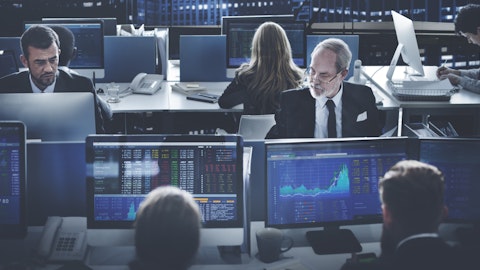Miller Value Funds’ Bill Miller recently delivered his market letter for the fourth quarter of 2018, in which he talked about his market expectations for the current year. To describe the tough market environment in 2018, Mr. Miller relied on the Chinese astrology by which 2018 was the year of the dog. In this way, he used humor to explain the results most of the investors had in the year behind us.
“From an all-time high reached on January 26, US stocks began a decline just as the Chinese New Year welcomed the dog, culminating in a decline of 6.2% in the S&P 500 before dividends and 4.4% after. That was the worst year in stocks since the 2008 financial crisis. December had its worst return in that month since 1931 when the economy was collapsing into the Great Depression.”
Continuing in the same manner, Mr. Miller informed his investors that 2019 is the year of the pig. “Market participants are likely to immediately recall the old saw that “bulls make money, bears make money, but pigs get slaughtered.” That would suggest a very dim view of one’s prospects if the pig is an apt metaphor for what we are likely to experience in 2019. I think, though, there is a better analogy than the bromide noted above. In 1992, George Soros and Stan Druckenmiller bet heavily against the British pound, expecting it to fall sharply. George kept telling Stan the position needed to be bigger and Stan dutifully increased it each time. Stan worried that the position had gotten too big, and when George told him again it needed to be bigger, Stan repeated the point about pigs getting slaughtered. George responded, “It takes courage to be a pig.” That courage was rewarded when the pound collapsed on September 5. Soros made a billion dollars and became known as the man who broke the Bank of England.”

Mr. Miller strongly believes that in spite of the obvious challenges that the market had posed to investors at the end of 2018, this year will once again fairly compensate those that are being bold. In the recent interview on CNBC, he has shared high hopes on Amazon.com, Inc.(NASDAQ:AMZN), predicting that the stock will double in the next three years. Amazon has been very popular among investors for years, and last year it was the third most popular stock among hedge funds in Q3.
Back to his Q4 Market Letter – he further explained that previous market crises, such as the one we experienced in 2008, always impact investors future behaviors, leaving them with fear of volatility and risks, and also pushing some to exit.
“The first six weeks of 2016 were the worst start to a year in the history of the S&P, and the 2018 December results were the worst in 87 years. The concerns then and now were macro and remarkably similar: fears the Federal Reserve would overtighten, fears that collapsing oil prices signaled a global economy that was rolling over into a recession, and fears that grim economic news out of China presaged a potentially dire, debt-driven downturn that would prove contagious. None of those came to pass, the fears were just that, and the stock market’s decline stopped just above the 200-week moving average of 1790 before beginning a recovery of over 1000 points over the next three years. Those same macro fears, along with a few new ones such as a messy Brexit, tariffs and trade wars, and the uncertainty of the Mueller investigation, have been bedeviling this market. Just as in 2016, the S&P’s decline halted (at least for now) at the 200-week moving average of 2350 and has made a sharp recovery in the first days of the New Year, albeit with considerable volatility.
I think it likely that the current, well-advertised macro worries will prove as ephemeral as 2016’s. The market clearly welcomed Fed Chairman Powell’s recent remarks that emphasized “flexibility, adaptability and open-mindedness” according to The New York Times’ Neil Irwin, and he dispelled fears that the Fed was ignoring market-based signals in favor of its academic models, saying the Fed would be “patient” as it considered the economic data. His remarks were followed by an “as good as it gets” employment report showing a remarkable growth of non-farm payrolls of 312,000, growth of average hourly earnings of 3.2%, and a modest uptick in unemployment to 3.9%, driven by an increase in the labor force participation rate. Inflation remained subdued. Stocks soared and bonds fell.
For investors, the sharp selloff from the September high of 2940 to the current 2530 level coupled with the rise in bond prices over the same period has stocks now priced at under 15x 2019’s estimated earnings compared to about 37x the annualized, hold-to-maturity return on 10-year treasuries. At 15x, the market is at the lowest point it’s been since late 2013. Corporate earnings and dividends should grow about 5% or so long-term, while today’s 10-year coupons will not.”
In conclusion, Mr. Miller once again talked about notorious 2008 and shared an anecdote about Warrant Buffet who was purchasing US stocks when almost no one was doing so. Later, when Mr. Buffet was asked how he new when it was the right time to buy, he answered that he didn’t. He just recognized tempting prices. Mr. Miller wrote that, just like Mr. Buffet, he doesn’t know when is the ideal time to make a purchase but that he finds US stock prices now the most favorable than they have been in the last three years. “As we enter the year of the pig, I think a slug of porcine pluck is called for.”





